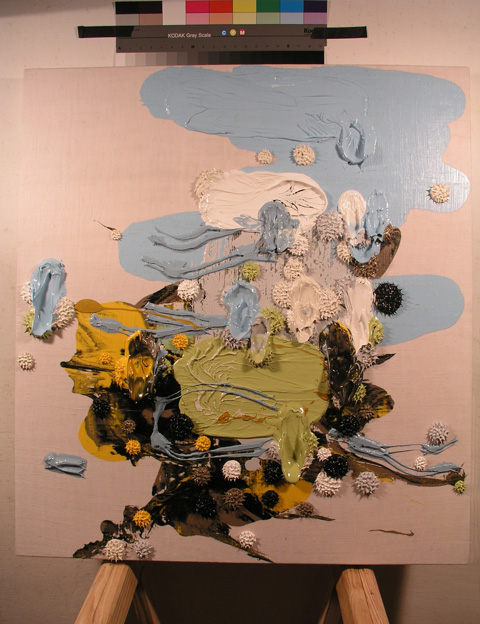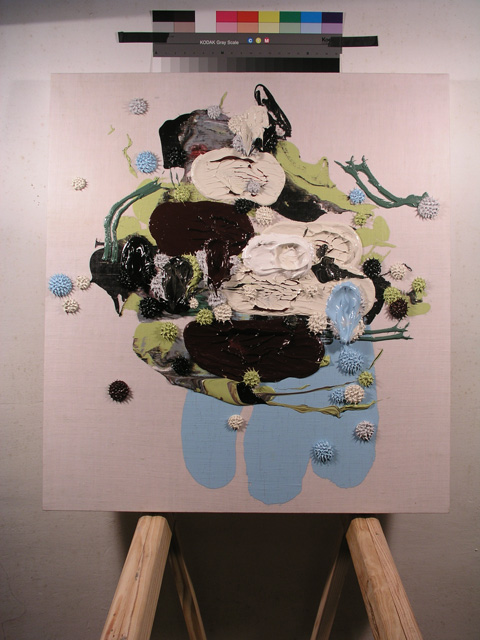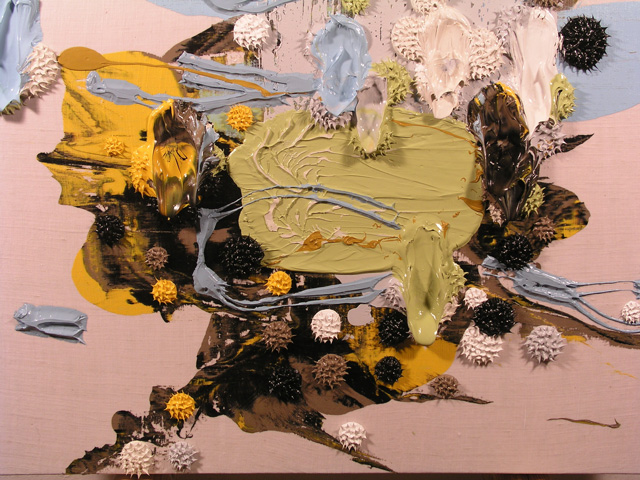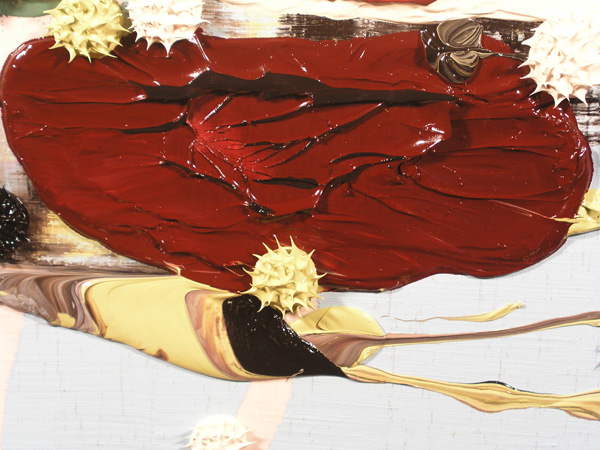August 8, 2004
Two in Rapid Succesion

After the larger paintings, I had ideas I wanted to extend and two smaller panels to exercise them on. These two brings the number of paintings bound for Z?rich to ten, the best I can do as we settle into the Costa Brava.

The last three paintings are taking a turn and I wanted to try to make this vivid in this post. It is in the use of paint applied and immediately removed. It comes from a longstanding practice of scooping paint, a removal, a figuration from evacuation. (Here's a painting in a blogpost on a painting that illustrates this.)
I had used it to establish large flat areas. In the last painting, you might notice the large marbelized areas, an experiment that was. In that last painting and these two subsequent ones, I used the blue and marbleized areas as a starting point and as a kind of drawing to establish the direction of the compostion.
These flat areas have the potential for drawing (dibujar), and it has a promise of extending a composition (larger), these frenetic marks figuring terminal ends of blob forms that provoke the figural. There was a cartoon in the thirties where one of the characters was a blobby, ghostly form with whiskers and a hat... on the fraying edge of my memory.
But I'm entertaining two contradictory ideas.
One one hand, I seem to have noodled my way out of the scale limitation of the way I've been painting for so long. By beginnning with a trowel of paint over the whole surface of the painting, the intensity I want to bring in this all prima method kept me within a certain size, the scale of outstretched arms. (Big exception: a couple of four meter paintings right before we left LA.)
Now, with the extendability of these initial drawings (pushing or throwing the paint on describes an edge, volume of color and edge of the outline are what remain after the paint is sheared off. Now, a painting can be any size because this "drawing" can be laid down relatively quickly.
Add to this the possiblity of working section to section as traditional muralists do and size is not problem. And to reiterate, working alla prima is easy when the painting is the size of one's arms outstretched... hard when it approaches instutional scale.
And this leads us to the other hand: this scale limitation might be worth fighting for. To keep the art experience in the intimate scale implied: the-you-are-there of standing in front of a painting within environments closer in scale to habitation than stadiums. Would Morandi have worked the way he did in today's wharehouse sized exhibition spaces? Tuttle certainly didn't have to.
Do I have to? Of course not. Do I want to? I'm not sure right now.
Details:

The first consequence of laying down the marbleiszed forms is that an open skein of paint is necessary, a net of mark making becomes desireable. As always, I want the best of every touch or mark of paint to show from the beginning to the end, each touch limiting the next, a chain of edits or masks covering the worst of each mark and showcasing the best aspects of form. I've always liked to see raw canvas in the middle of a heavily worked painting, evidence of grace under fire.
Here's a detail of the second of these smaller panels, the last painting painted for the group of paintings bound for a theshow in Z?rich.

Unlike the last larger painting, I'm not pulling the compostion to the edges of the frame. I followed the simplicity and kept from pulling the paint to the edges, allowing a figural congealment around the first flat marbleizing actions.
Fewer marks, more suggestion per mark.
This last pic is distorting the color, the red (alizarin crimson dented towards indian red with black and burnt umber), so here's a close-up to correct the record:

AH, that's better.
... but the green is off. Oh well. That's color for you.
Posted by Dennis at August 8, 2004 8:53 AM
0cd2b8cc856370994873e2761c5ff9e1 ff2f9.